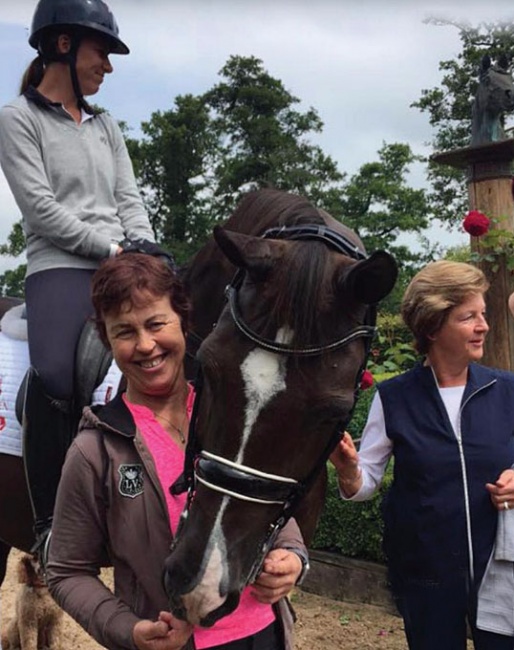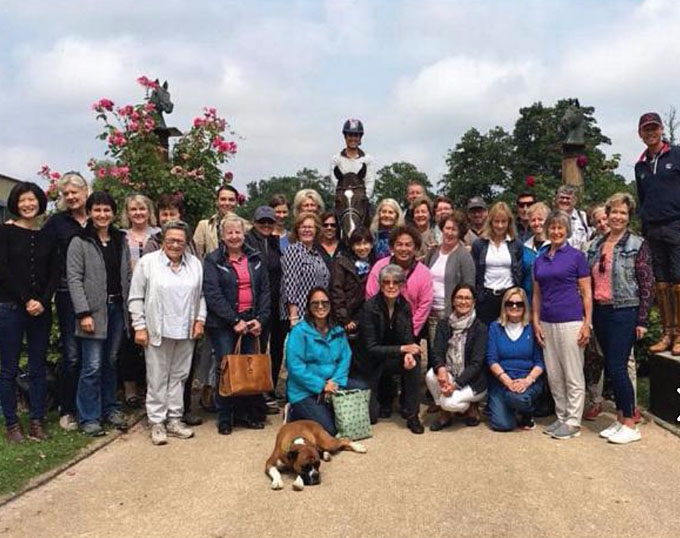
By Barbara Chalmers – List A Judge Otago - first published in Dressage NZL Bulletin 36
Thirty judges from England, New Zealand, Australia, Singapore, Czech Republic, China, Chile, Japan and the Philippines gathered at Hartpury College in the UK for three intensive days of learning at the 2019 International Dressage Officials Club (IDOC) FEI Re-fresher Clinic and Regional Forum
Aside from the hugely beneficial ongoing development for FEI judges, the IDOC (International Dressage Officials Club) clinic also presented a world class opportunity for national Grand Prix judges to experience real international hands on judging in a workshop situation participating in an international clinic at an international show, which would otherwise not be open.
Hartpury provided the perfect venue with the participants able to stay on site in the student accommodation, handy for early starts and late finishes, and networking over meals in the university’s many cafeterias. The hosts many sport academies, and the equine facilities are world class including two indoor arenas, outdoor arenas and warm up areas, water treadmills and a therapy centre, cross-country courses, plus stabling for 230 horses.
The key presenters were FEI 5* judges Susie Hoovenaars (AUS) and Isobel Wessels (GBR). The clinic ran over three days, combining classroom theory, lots of practical judging with headphones, and taking turns to judge and comment on the microphone. Both Susie and Isobel showed amazing sheer energy levels and ability to focus and educate the group.
Early mornings saw us in the classroom for theory sessions, then off to a dedicated tent at the A end of the main arena to do our judging. This was quite nerve wracking as nothing escaped our two mentors, who were keen for us to be the best we could be.
Key messages
- Ensure your comments are positive; the mark is the mark, but judges need to be encouraging. e.g. in the collective remarks where a rider had problems with the sequence changes “a pity about the tempis today but showing some…..”.
- Two points difference between judges is considered too much on a movement.
- Never be afraid to be different as long as you have a reason and be honest.
- The UK also has a difference form to be completed if there are differences between judges of more than 7% within a class, outlining reasons and facilitating understanding of why there were differences – this is a positive thing “otherwise we may as well just all sit at C and be in a huddle” Isobel emphasised.
- It is never negative to discuss things
- Don’t try to be in line with everyone else as you will never get there
- The TEAM will always save you
- The judge at C makes ONE statement on behalf of the group – not individual responses
- Even if you disagree, you have to conform with the judge at C (this is actually in the rule book).
- Be honest and pleasant when discussing their marks with riders/coaches afterwards – they haven’t been watching every horse, every movement, from your position.
- Be confident to use both ends of the scale.
- Never discuss differences in public with your judging colleagues – show support and do this in private.
- You cannot blame the writer for anything – it is the judge’s responsibility
On Judge Fitness
The brain is a muscle – stay fit, it’s not just the riders who need to be fit. When sitting for a long-time hydration is important, watch the coffee or sugar hits. Judges have to complete a number of tasks simultaneously. According to experienced AUS 5 * judge Mary Seefried, judges have six tapes running together
- One observing the test pattern, exact beginning and end of each movement
- One monitoring the basics and criteria and evaluates the result
- One assigns a word and a number
- One determines how to formulate what is being dictated to the writer (helpful comment)
- One monitors the “extras” (ie the writer keeping up, is the rider’s equipment correct , is there a loose horse outside the arena etc)
- One measures the issue that will affect the collective mark so the judge will know what to award and the relevant comment

Associate with the Training Scale.
Isobel gave a beautifully clear talk on the Training Scale and its importance at the start of the clinic. If the first three points on the training scale are in place, then energy has a route which the rider can then take back or more forward. The rider knows how much they can ask; it is not always possible to ask for more (if tense or not quite balanced), so be careful with your comments as too much impulsion does not help and the horse will become more tense and /or too fast.
On Regularity and Welfare
If a horse is definitely irregular, or you feel that the horse cannot cope mentally or physically with the tasks, you have to ring the bell.
On the Movements & Way of Going
- Distinguish what is natural versus man-made, e.g. a passagey trot. A slowed-down trot is not passage at the higher levels. There are 10 marks for the canter to trot transition in the GP, this comes into straightness
- Only a straight horse can be ridden correctly in leg-yield
- In the Prix St Georges it is not counter canter after the half pass then change; if they do this (rather than straighten, change) then deduct 1 mark.
- In canter pirouettes the horse must not leg-yield in or flex the other way (the rider is not able to control the horse unless in correct flexion, and this affects the turning and pirouette; riders sometimes flex to the outside as they can’t keep the outside hindleg engaged in the pirouette).
- Watch at the lower levels in particular that the horse is not going quite quickly to conceal the lack of collection.
- When the neck gets a bit short this affects the cadence, contact problems affect the rhythm.
- Be guarded with comments, e.g. on one horse instead of “behind the leg” it was better to say, “tilted in neck, unable to come forward”.
- • Watch the test e.g. that the movement goes through the short side after the extended trot. Comment as the movement happens then when you get to the end, the mark is there. Don’t worry about ranking – the horse will do that for you.
On the Piaffe
- In Piaffe, start counting when the legs start moving (sometimes the riders count when they start giving the aid and can get confused with the number of steps produced); if they take the risk and ask for the full number of steps (12-15) reward them. If they only do 50% of the steps it’s a 5 or below, deduct 1-2 points if not accurate or if they only do 70-80% of the steps, if they are really advancing it’s a 3 or below, if they do passage on the spot instead of piaffe this is cheating and only a 6-7 (and if the transition is from this rather than a true piaffe then the transition mark has to be the same as the question here is for the horse to go forward from the closing). At Grand Prix level 8 steps piaffe is not enough and less than 8 steps would get a mark below 5.
- Watch – if the Piaffe is creeping then often the transitions creep too and shorten the distance the horse should show in the passage.
Judges are not Policemen
- Judges are “quality controllers, not policemen”. Be honestly kind.
- If there are lows of 1 or 2, you can’t have a rider mark more than 7. Do not use the word “tension” unless you really see it, often it’s concentration or the horse offering more, or too much.
- Better to say very disobedient rather than resistance. Ignore the tail – an active tail is often seen in mares who are a bit sensitive, ears are a better indication.
- Better to use “carriage” as a comment rather than self-carriage – it’s quicker.
- “Better rhythm behind” is better than saying long/short and trying to say which hind leg.
- Better to say “deep” rather than poll higher if you need to be quicker.
- Be aware of the direction of our sport. Mark up because of, rather than down in spite of.
- Don’t stick on low marks after a horse reacts to something, be fair to the end mark.
- Don’t overmark those who avoid the risk and point of the exercise, reward those who do.
On the Development of the Horse

Observations
I watched the warmup ring as much as possible, and the lasting impression was the high standard of horsepower and riding; how calm everything was; little sign of rider tension or nerves, and a lot of support teams in action.
There were some really talented and effective riders, especially Gareth Hughes, Carl Hester, Charlotte Dujardin, Laura Tomlinson (nee Bechtolsheimer), and Lara Butler to mention a few, plus some talented young riders training with them. It was interesting to see the top guns riding, then coming back to watch and support other riders. These riders have serious core strength and barely move in the saddle, with very subtle aids.
A big thank you must go Maria Schwennesen (AUS) from all participants for all her organisational work from home in Australia to make it all happen .
NZL Judges at Hartpury
Clinic: Linda Warren-Davey, Betty Brown, Mura Love, Judith Cunningham, Barbara Chalmers, Gill Morley, Carol Eivers NZL FEI 4* Judges Sue Hobson and Helen Hughes-Keen officiated at the event
A real treat to finish

Jane Ventura, Barbara Chalmers
A big thank you to Isobel for having the connection with Carl and Charlotte to make this visit possible. I came away truly humbled and inspired.